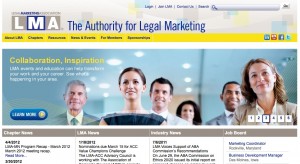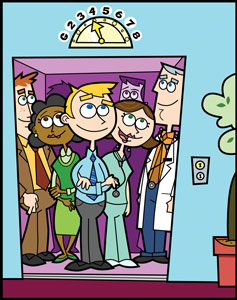 A huge source of information about the law resides in lawyer authored blogs, says Rees Morrison, who blogs at LawDepartmentManagementblog.com.
A huge source of information about the law resides in lawyer authored blogs, says Rees Morrison, who blogs at LawDepartmentManagementblog.com.
Rees is a law management consultant. However, when it comes to finding management related content on the Web from in-house counsel, the story is a quite different. Social networks targeted to in-house counsel get most of their management [related] comments from non-practitioners.
“Having hosted for more than a year discussion groups on LinkedIn about law department management and on Legal OnRamp about legal department operations, I can attest that very few in-house attorneys either start topics or comment on topics,” stated Rees on his blog post of June 1, 2009.
I’m not surprised, at all. Why? Aside from factors such as time, confidentiality, and other resources, why do in-house counsel need to post on social networks? Don’t they get their information from, and exchange ideas with, their trusted advisers and staff? What does public discourse add to the equation?
I believe most lawyers can agree that you need to listen to your client (internal or external) first before you decide what they need. Right?
No doubt that despite the best of intentions of the network creators, if the audiences they seek to engage aren’t creators, but rather spectators, they probably didn’t do their “listening” homework.
Trying to drive home the idea that anyone starting or joining a social space on the Web, for business, marketing or whatever, needs to take a good hard look at who they are trying to engage, Forrester analyst Charlene Li so aptly described in her 2008 book Groundswell, the six “types” of online adults; Creators, Critics, Collectors, Joiners, Spectators and Inactives.
The Forrester 2007 North American Social Technographics Online Survey found that only 18% of online U.S. adults were Creators compared to 25% Critics, 12% Collectors, 25% Joiners, and a whopping 48% Spectators and 44% Inactives.
BUT, that’s not all… the 2008 profile reveals that Creators are now at 21%, Critics 37%, Collectors19%, Joiners 35%, and Spectators are now 69% , Inactives 25%. So, while Creators increased marginally 3%, Spectators increased 21% and Inactives are DOWN 19%. Is it logical to deduce that the Inactives became Spectators? And is that the way the social Web is trending? Probably…
Again, taking into consideration the hard and fast facts of managing a legal practice, e.g. time, confidentiality, and resources, those percentages are likely not even close when talking about the in-house legal community (or the high-powered corporate law practitioners). However, consultants, those who “talk” and “interact” for a living, are high in the Creator and Critic categories, thus, they share freely and often. But, I don’t think that’s the end of the story.
Is it just the legal industry that’s slow to adopt? Are there other factors at play?
The legal industry is not the only industry where top people aren’t converting to the social Web. Fast Company recently published their 100 Most Creative People in Business. In a related article, “Why Are the Most Creative People in Business Opting Out on Web 2.0?” they report that, roughly only a quarter of the creative class has embraced social networking services. Some say it’s a time drain. Others choose to keep their thoughts and pictures to themselves.
I get it.
So, what’s my conclusion? Only when it becomes mission critical, e.g. their clients or constituencies (internal or external) demand it; will the lurkers turn around and join the love fest. Good news is that those forward-looking networks that got out in front of the pack will be well positioned and well stocked when more in-house counsel and private practice leaders come on board.
Till then, the Creators are building an incredible library of ideas that would not have ordinarily, in the Web 1.0 world, seen the light of day –let alone the printing press. And with the viral nature of Web 2.0 where the content is seen by far more people than those who visit an enterprise Web site article database, this is an incredibly efficient and effective (two words lawyers love to use) distribution channel.
All you Creators out there, not only bloggers and social networking fans, but also those who comment and add their two cents to an online discussion, keep up the good stuff! You are a round peg in the round hole!




I couldn’t agree more with the comments in this post. As a member of team responsible for Martindale Connected (www.martindale.com/connected), I get that we’re still in the early stages of Web 2.0, where most of the fanfare still centers around the promise and novelty of the technology itself, and not the business value it brings to lawyers. It is only when professional networking evolves to bring this latter value, that its true merit will be appreciated by busy lawyers, and uptake will be more substantial.
Some sites get this, others don’t. At Connected, we’ve started building some of these integrated business tools into the site already, and many more are in the works. For instance, we’ve integrated Connected with the Martindale database of 1,000,000+ lawyers, as well as the LexisNexis database of lawyers, to solve one of the early-adopter problems of legal professional networks: “How do I grow my network of trusted referrals”?
So for instance, even while our network is small (but growing) at 7500+ lawyers, we are plugged into more than 50 million relationships between lawyers around the world. We bring those relationships to bear in Connected by: 1) suggesting connections to new members — lawyers they’ve worked with in the past, lawyers they’ve graduated law school with; lawyers who appear on published case opinions; etc.; 2) Those relationships are integrated with the Martindale.com directory. Meaning, when a Connected member does a lawyer search, search results will be stack ranked based on connections — how is the user connected to the lawyer in the search result. The result combines the power of a ubiquitous, global directory with the Web 2.0 platform to create applications that weren’t possible before. And they solve real world needs (ie how do I find a trusted referral? Who do I know that knows the judge I’m arguing before, etc. etc.)
Other examples of Web 2.0 applications that provide business value to lawyers are coming — at least on Connected. Think preferred provider management; Client Review; integration with traditional legal content and research to provide 360 degree views of legal topics — both from formalized research to user-genereated content.
But the point is that Web 2.0 sites, without more, holds value to a portion of lawyers who are more sophisticated about their networking and collaboration. It will hold universal appeal only when professional networking sites start leveraging the incredible power of these platforms to build tools and business applications that solve problems, reduce costs, and create efficiencies — helping lawyers do their jobs better.
John,
From your description of Martindale Connected and the integration and automation you are building into it, you obviously know your audience. Those are time savers with benefits. This is great stuff. Thanks for sharing. I hope that your members get real value from the service now and in the years to come as it evolves. It’s fun to think of what the future holds.